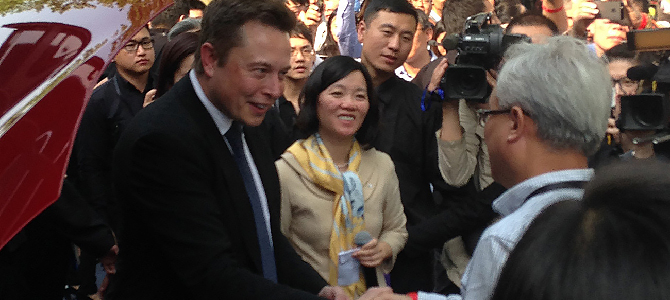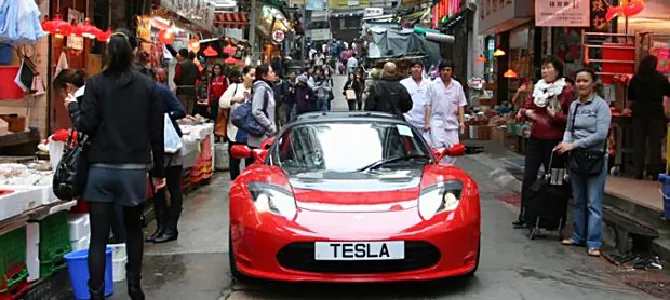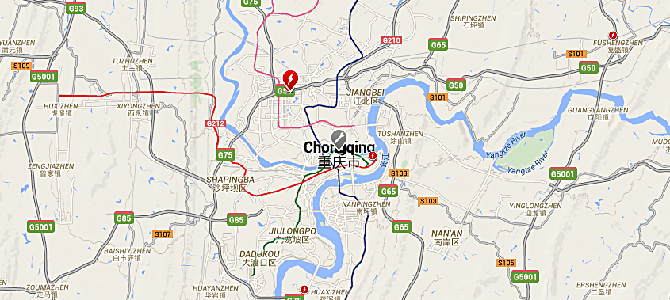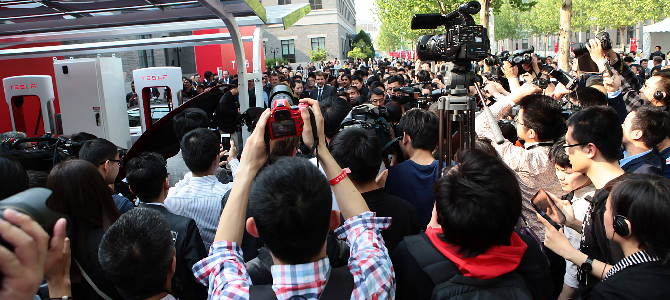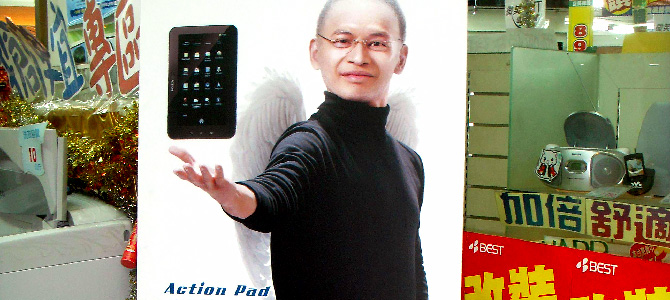The 4th installment of Auto Industry 101 won’t be a lecture on how to successfully export an electric car to China. There isn’t enough empirical data for this: No-one so far has successfully exported an electric car to China. Today, we explore the reasons. This short course is written due to the recent interest in disrupting the auto industry. The course is kept extremely simple, Auto Industry for the Twitter Generation. Those in the industry will find nothing new. Those new to the industry hopefully will find a helpful primer. This lecture may be a bit long. So here is the executive version on how to export EVs to China:
Don’t.
I drove my first electric car in China in early 2007, at around the same time Tesla showed its first Roadster. The Chinese EV was a prototype, built by the Anting Automotive College of Shanghai’s Tongji University. A formal meeting was scheduled for the next morning. The next day at the college, everybody was aflutter, and the meeting was canceled. “Last night, the boss has been called to an urgent meeting in Beijing,” the distraught Dean of the college told me. “No reason was given. We hope he will come back.” At lunch, a call came, and to everybody’s relief and joy, Wang Gang, the President of Tongji University and founder of the Anting College, was installed as China’s Science and Technology Minister.
Suddenly, EVs had a strong and knowledgeable sponsor, right close to China’s very top. Wan Gang had powerful allies: China’s military. The brass was worried: Car sales began to boom in China, and the gasoline in the tanks mainly came by tanker from the Middle East. There had been two Gulf Wars in short succession, and Iraq was falling apart. There was a protracted war in China’s western periphery, in Afghanistan, and the unrest began to affect China’s Xinjiang Province. A flare-up around the Malacca Straits could easily choke China’s oil supply. China’s generals were old enough to remember that World War II did not start in Pearl Harbor, but a year earlier, when America cut off Japan’s oil supply. A big push for EVs promised independence both from Saudi oil, and from imported western technology. Powered by the vast scale of its market, Chinese would assume technological leadership in new energy transportation, while the west would choke on ICEs.
At least, that was the plan.
Foreign involvement in this plan was not very much welcome. China wanted to take its future into its own hands, and it wanted the electric car technology to be firmly in same. China’s more than 100 carmakers were told to build EVs. They were threatened with consolidation, and they were exempt from consolidation if they built EVs. Soon, there were more EVs at Chinese car shows than scantily clad girls.
China’s joint ventures with western automakers were not allowed to sell a Made-in-China EV under their strong brands. A Nissan Leaf had to be a Venucia, a Chevy Volt a Baojun. By government edict, brands and technology of EVs had to be owned by the joint venture, and no longer by a foreign license holder. Nissan launched its Leaf in China as the Venucia e30, to very limited success. GM, egged-on by Michigan lawmakers, insisted on making the Chevy Volt as a Chevy Volt in China , only to run into a Chinese wall. GM didn’t want to hand over its vaunted tech to the Chinese and sell the Chevy Volt as Baojun Joule. To maintain face, GM exported a few token Volts to China, but nobody wanted them.
GM quickly realized what every budding importer of foreign EVs to China will find out in this chapter of Auto Industry 101:
There is no problem importing EVs to China. Pay around a million dollars to have the car CCC certified, a pittance compared to what it costs in America, and the doors are open. Perhaps, only the doors to a huge warehouse where you stash your imported EVs.
There is a huge problem selling the imported EV in China. The import is saddled with freight costs, a 25 percent import tariff, a 17 percent value added tax, and a 10 percent purchase tax on the total. EVs made by 11 domestic auto manufacturers are exempt of the tax. Imports are not. (Early reports said they were. They weren’t.) EVs made in China qualify for a nearly $10,000 subsidy from the central government, and another $10,000 subsidy from some local governments. Imports do not. Only idiots would try to compete here.
The growing number of electric vehicles sold in China may seduce some to ignore the lopsided playing field. Then they find out that most of the EVs sold in China are bought by governments. Under a new law, electric cars must make up at least 30 percent of government vehicle purchases by 2016. The central government owns a few carmakers. Most large regional governments own at least one carmaker. Guess who’s EV they will buy.
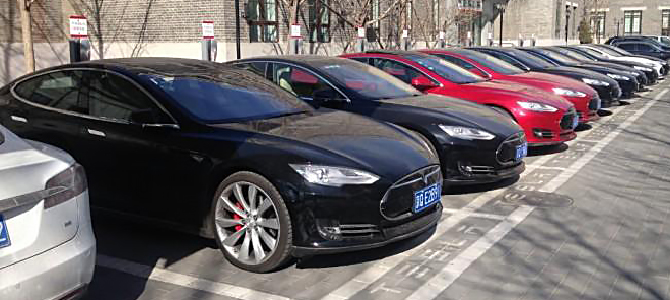
Model S lining up in front of Tesla HQ, Beijing. Picture Carnewschina.
Should we, like Tesla, insist on selling our cars through our own network of dealers, nobody will stop us in China. China isn’t America, it’s an open market, at least when it comes to the selling of cars. However, once we start selling the cars, our stores will run into robust competition. Not only is China a nation of traders (everybody is selling at least something), many of China’s biggest car dealers are owned by the government, one way or the other.
Beijing’s largest dealer group is owned by the City of Beijing through a series of shell companies, known as the Beijing Xianglong Group. It started out as the repair shop of the bus company. It also operates a huge fleet of taxis along with a conglomerate of other companies. Go to any of their dealers, and you won’t notice that they are owned by the same city that pretty much outlawed car buying.
Sinomach Automobile is China’s third largest dealer group, and it is less circumspect. Sinomach Automobile is owned by China National Machinery Industry Corporation (a.k.a. Sinomach) a huge government-owned conglomerate that makes everything from arms to China’s space capsule. Anyone eventually has to deal with these state owned giants in China, even Tesla. Sinomach provides import agent services to Tesla, and it helped the company to obtain China Compulsory Certification (CCC) license, necessary to put the imported EVs on China’s roads.
And the list goes on. When Volkswagen started out in China, the distribution organization was the Chinese army, and as rumor has it, the army may still be holding on to a few dealerships.
So now we found out that we aren’t just competing with global carmakers who teamed up with the government. The dealer down the road also is a government agent. Surrounded by a well-connected competition, we better get some trusted advisers, and we better listen to them. With a good adviser and a good listener, Tesla probably would have put its first store into Shanghai, and not into Beijing. A good adviser who knows the auto industry would have told Elon Musk that there are some 25 EV pilot programs running in 25 Chinese cities, and that there are only five of consequence. In China, connections are everything, and it would have helped Tesla if it would have involved itself in these pilot programs.
The only pilot program city with a mandate to reach out internationally was Shanghai. Oddly, Tesla was dragging its heels in Shanghai, leaving the city without a Tesla store for many months after coming to China. Shanghai was ready for Tesla. Oblivious, Tesla put its first store into Beijing, where it wasn’t wanted. Aside from its own dealer group, Beijing also owns BAIC, a joint venture partner of Daimler and Hyundai. Beijing’s part in the experiment was to establish a strong industrial base for EVs. A foreign EV company may have been welcome in Beijing if it would have committed to developing electric motors, inverters or batteries in one of the EV research campuses Beijing created. Tesla opened a store in Beijing in a time when many downtown Beijing car dealerships were shuttered, after the city’s license plate lottery brought the Beijing car market to a halt.
The electric grid in China is still a bit fragile, in some areas, blackouts during summer times are common. Slow charging is en vogue in China, because it doesn’t tax the grid so much. Chongqing. the world’s most populous “city,” is close to the Three Gorge Power Grid, and it was the only city that could focus on fast chargers. Chongqing would have been an ideal place for Tesla to develop the supercharged connections so necessary in China. Quite puzzlingly, Tesla, the company known for its Supercharger network, is AWOl in China’s fast charger capital Chongqing. Tesla operates one supercharger in the city of more than 30 million. It has neither store, nor service center there. The map shows a service center as planned.
Musk prides himself that he can move his cars without advertising. A charismatic leader with a devoted cult following, all he needs to do is make a few pronouncements via Twitter.
There are two problems to that in China.
A,) There is no Twitter in China. Twitter, Facebook et al are blocked, and the homegrown equivalents are heavily censored.
B,) A sure-fire way to make your life hard in China is to start a cult. Don’t laugh. For ten years, innocuous direct-sell organizations like Amway, Avon, May Kay and others were outlawed in China as “evil cults, secret societies and superstitious and lawless activities.” Under pressure from the U.S.A. after China’s WTO accession, China lifted the ban. The cleaning liquids and lipsticks still must be sold through regular stores.
Tesla stores are heavily influenced by Apple stores. Tesla loves to be seen as the Apple of cars. It would have behooved Tesla to take a full page out of Apple’s China strategy, and not just the Apple Store chapter. Apple produces in China. China is dependent on Apple jobs at Foxconn et al. Apple is dependent on iPhone sales in China. Codependency always makes for a lasting marriage. Apple is a wonderful example of how to succeed in China, of how to build two-way streets with room for give and take. You give investments, you give jobs, and you can take a market.
In 2009, subsidized iPhones became available at China’s #2 mobile carrier China Unicom. Last year, iPhones could be bought by the 807 million subscribers (at last count) of China’s (and the world’s) largest carrier China Mobile. (Interesting factoid: As of 12/31/2014, China had 1.3 billion mobile phone subscribers, that’s pretty much one contract for every man, woman, child, and inmate in the country of 1.3 billion.) This year, China will eclipse the U.S. in iPhone sales. Apple would not be in this position if the iPhones would be imported from Cupertino.With production in China, Steve Jobs could even get away with being a bit of a cult figure.
Instead of copying Apple’s smooth China strategy, Tesla bumbled into China, and it keeps on bumbling. To this day, there is no working satnav on the large display of the Model S, because the factory version is based on Google Maps. Google Maps are illegal, and blocked in China. Technically, the use of unlicensed GPS maps can get you in jail in China, and occasionally, it does. In America, the brain in the Tesla solves range anxiety. In China, it can’t even show the next freeway exit.
Instead of Apple, Tesla resembles Google in China, and that’s not a good thing. Google left China in a huff after it was hacked, supposedly by Chinese government agents. Google did not leave the U.S. when the NSA gained backdoor access to Google systems. Two years ago, it turned out that the Chinese came through the same backdoor that was installed for the NSA. For its Chinese blundering, Google’s Android operating system now powers all Made-in-China phones (except those made for Apple) and Google does not see a dime for it. In China, Google Search, Google Maps, Gmail, anything by Google is removed and replaced with indigenous software. Tesla could have Baidu Map on its bound-for-China Model S, but it didn’t. Late last year, Tesla finally wised up to the missing satnav and cut a deal with China’s Navinfo, a state-owned company with ties to the Chinese military. The system should arrive real soon now.
This has gotten much too long for the EV-in-China chapter of Auto Industry 101. Someday, a book will be written on how Tesla blew it in China, and I don’t want to write it. The next and last chapter of Auto Industry 101 will assume that you successfully built your car company, and that – exit strategy is everything – you want to sell it. Don’t forget to bring tissues.
P.S.: If you want to know which EVs are really selling in China, by the millions, follow Tycho’s Carnewschina reports on Low Speed Electric Vehicles. Actually, follow Tycho on anything about cars in China. He heroically still lives there. I left a year ago, wearing a “I can’t breathe” t-shirt.
